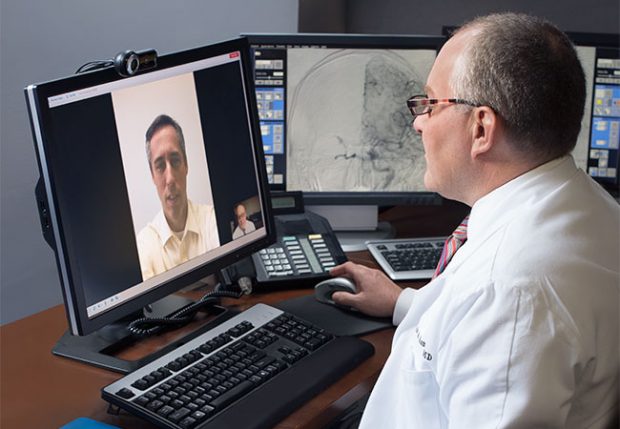Often associated with video games, Virtual Reality (VR) has brought about a revolution in the healthcare industry. VR is proving to be a powerful health tool. It will undoubtedly have a profound impact on our wellness and longevity. Here’s why.
Virtual Reality As It Evolves Into Wellness
Virtual Reality, or VR as it is more commonly referred to, can be defined as an artificial, fully immersive experience that obscures the natural world. It’s a computer-generated environment that allows its users to explore and interact with virtual, controlled surroundings in a way that approximates reality. Instead of looking at a screen in front of them, the user interacts with 3D worlds, becoming fully immersed in them.
Dr. Brennan Spiegel, director of Health Services Research at Cedars-Sinou sums it up best. “A lot of people think of VR as it relates to gaming and entertainment devices, but when used positively, VR can be a profound benefit to human health,” he says.
Sherman and Craig sum it up through its essential elements, namely “a virtual world, immersion, sensory feedback (responding to user input), and interaction.”
Virtual Reality is changing healthcare delivery
In recent years, the incorporation of VR into healthcare has progressed significantly.
Virtual Reality has played a role in providing more effective, theoretical learning for medical school learners, graduates, and healthcare professionals. It has allowed for the inspection of 3D medical models (which cannot be reproduced in physical models) in detail. This allows them to gain hands-on skills in risk-free conditions.
It also allows them to learn how to communicate with Ai-controlled virtual patients. Their behaviors can be altered for various learning purposes (for example, how to treat a patient with dementia).
Surgery Practice
VR allows surgeons to perform various mock surgeries, which allows them to eliminate any practical skill deficiency before an actual surgery needs to be performed. This allows them to become skilled professionals without using expensive one-time-use mannequins for training.
Pain Management
According to research, VR can help increase tolerance to a minor, but painful procedures such as getting stitches or having a dislocated joint pushed back into place. It does this by inducing a state of deep relaxation through its graphics and sounds
VR can also be utilized to alleviate pain experienced during intense physical activity. In a 2019 study, participants were split into two groups, with the first group exercising in a gym, and the second group using a VR headset. Participants who utilized VR experienced 10% lower pain intensity. They also experienced slightly higher stamina, with their exercises lasting about 2 minutes longer.
Rehabilitation
VR plays a role in helping those affected by strokes, balance disorders, and Parkinson’s Disease, amongst others. It can turn a patient’s therapy sessions into a fun, interactive experience that motivates them through virtual goals and achievements.
VR assists patients in relearning how to perform their typical daily actions in a safe, controlled environment, with the illusion of their desired environment. It helps them restore motor skills and improve their spatial orientation abilities. This then protects them from posing any risks of damage to themselves or others.
We see this through the treatment of Lymphedema. This is a condition that began to gain media attention after talk show host and TV personality Wendy Williams shared her ongoing health battle with the condition.
Managing diseases
Being the most common cause of morbidity after mastectomies with axillary lymph node removal, Lymphedema refers to tissue swelling caused by the accumulation of protein-rich fluid that is usually drained through the body’s lymphatic system.
In a study published in the Journal of the Egyptian National Cancer Institute, the therapeutic efficiency of VR compared to Proprioceptive Neuromuscular Facilitation (stretching technique utilized to improve muscle elasticity) was observed. The analysis of the improvement percentage showed that the lymphedema state and upper limb function had improved more in the VR group compared to the PNF group.
Virtual reality as we live longer
VR will offer humanity a range of medical solutions that have been difficult to manage in cost and time effectively. This will be true for people everywhere. Scientists believe age, ethnicity, and gender will not be a barrier to the application of VR in health.
And contrary to popular belief that technology favours the young, older people will also benefit greatly from VR.
The U.S. Census Bureau, the National Center for Health Statistics, and the Bureau of Labor Statistics report show that the 85 and over population is projected to more than double from 6.4 million in 2016 to 14.6 million in 2040 (a 129% increase).
People are living longer. Persons reaching age 65 have an average life expectancy of an additional 19.4 years (20.6 years for females and 18 years for males). They are also going to live at home alone longer.. Already almost half of older women (45%) age 75 and over lived alone.
There are many positive aspects to using VR in older adults
According to research published in Frontiers in Virtual Reality, older adults will experience different but many positive potential benefits when including VR/AR tools in their everyday lives. The report makes for essential reading for those interested in VR’s impact on health.
Virtual reality and mental health
One of the key areas of use will be to tackle mental health. VR can be a very useful tool to combat issues of loneliness and isolation, which are more prevalent among the elderly as a result of a number of factors, including bereavement.
Virtual reality and mindfulness
Mindfulness is defined as “the practice of being fully present and focused.” As it is a practice that trains you to control your thoughts, which assists you to remain calm in the most stressful situations. This has been shown to alleviate thoughts of anxiety and keep depression/depressive episodes at bay.
Due to how immersive it is, VR makes it possible for one to create a tailored environment that is conducive to meditation. This allows them to be present in the moment without the distractions of reality.
Improving Sleep Quality
Paired with mindfulness practices, VR can play a role in improving sleep quality by encouraging deep sleep.
A study was conducted to observe the effect that VR has on the sleep quality of patients in Intensive Care Units. Activity tracker assessments showed that although sleep times didn’t differ between the control and experimental groups, those who used VR showed longer deep sleep times and higher sleep efficiency.
The downside to VR
Reduced face-to-face communication
One of the key challenges in utilizing VR applications in healthcare is how it reduces face-to-face communication and medical relationships between the patient and physician.
For example, VR makes it possible for patients to perform rehabilitation exercises at home. This then limits their interaction with physicians. Unfortunately, this could also negatively affect the effectiveness of the program as there is no professional supervision.
Training shortfalls
As effective as VR can be, it is not a “one-size-fits-all” solution, and therefore cannot be treated as such. Successful implementation of modern technology in healthcare requires extensive research and training.

Insufficient training of healthcare professionals in the proper use of this technology could result in poorer health outcomes. Especially for therapeutic purposes, poor training can lead to adverse consequences and exacerbated side effects.
Physical Side Effects
Prolonged exposure to VR has been shown to lead to numerous side effects, including headaches, eye strain, and cyber sickness.
Cybersickness occurs when the eyes perceive movement, but the vestibular system (the mechanism of the inner ear which is responsible for spatial awareness and balance) believes that the body is at rest. These mismatched signals result in this form of motion sickness.
The Future of VR in healthcare
So far, the positive application of VR far outweighs the currently accepted risks. VR in healthcare is still in its infancy. Yet, with more research being conducted, it’s safe to assume that in the coming years, we will see more implementation of it in the industry. It yields positive results across the healthcare spectrum, not only for patients but for healthcare professionals too.
VR and AR offer unique and innovative opportunities for millions across age, gender and ethnic groups. Older adults, their relatives, and their professional caregivers can also take advantage of these tools to improve their daily lives.
However, the use of technology can be challenging, especially when older adults lack access to new tools or digital skills. Developers, practitioners, and researchers in the field must acknowledge digital inequalities and provide older adults with training tools, support services, and digital solutions that consider their heterogeneous backgrounds and needs.
By revolutionizing how the treatment is provided and giving doctors more hands-on, risk-free training in controlled environments, healthcare capabilities will be greatly enhanced through this technology.
References
- Sherman, W.R. and Craig, A.B., 2018. Understanding virtual reality: Interface, application, and design. Morgan Kaufmann.
- Lányi, C.S., 2006. Virtual reality in healthcare. In Intelligent paradigms for assistive and preventive healthcare (pp. 87-116). Springer, Berlin, Heidelberg.
- Saab, M.M., Landers, M., Murphy, D., O’Mahony, B., Cooke, E., O’Driscoll, M. and Hegarty, J., 2022. Nursing students’ views of using virtual reality in healthcare: A qualitative study. Journal of Clinical Nursing, 31(9-10), pp.1228-1242.
- The Use of Virtual and Augmented Reality by Older Adults: Potentials and Challenges
https://www.frontiersin.org/articles/10.3389/frvir.2021.639718/full





![women [longevity live]](https://longevitylive.com/wp-content/uploads/2020/01/photo-of-women-walking-down-the-street-1116984-100x100.jpg)









